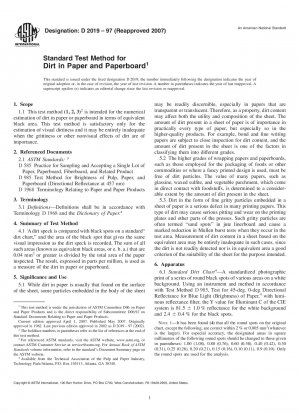ASTM D2019-97(2007)
Standard Test Method for Dirt in Paper and Paperboard
- Standard No.
- ASTM D2019-97(2007)
- Release Date
- 1997
- Published By
- American Society for Testing and Materials (ASTM)
- Status
- 2010-08
- Latest
- ASTM D2019-97(2007)
- Scope
While dirt in paper is usually that found on the surface of the sheet, some particles embedded in the body of the sheet may be readily discernible, especially in papers that are transparent or translucent. Therefore, as a property, dirt content may affect both the utility and composition of the sheet. The amount of dirt present in a sheet of paper is of importance in practically every type of paper, but especially so in the higher-quality products. For example, bond and fine writing papers are subject to close inspection for dirt content, and the amount of dirt present in the sheet is one of the factors in classifying them into different grades.
The higher grades of wrapping papers and paperboards, such as those employed for the packaging of foods or other commodities or where a fancy printed design is used, must be free of dirt particles. The value of many papers, such as glassine, waxed sulfite, and vegetable parchment, which come in direct contact with foodstuffs, is determined to a considerable extent by the amount of dirt present in the sheet.
Dirt in the form of fine gritty particles embedded in a sheet of paper is a serious defect in many printing papers. This type of dirt may cause serious pitting and wear on the printing plates and other parts of the presses. Such gritty particles are often termed “sand spots” in jute linerboard and cause a marked reduction in Mullen burst tests when they occur in the test area. Measurement of dirt content in a sheet based on the equivalent area may be entirely inadequate in such cases, since the dirt is not readily detected nor is its equivalent area a good criterion of the suitability of the sheet for the purpose intended.
1.1 This test method (1, 2, 3) is intended for the numerical estimation of dirt in paper or paperboard in terms of equivalent black area. This test method is satisfactory only for the estimation of visual dirtiness and it may be entirely inadequate when the grittiness or other nonvisual effects of dirt are of importance.
ASTM D2019-97(2007) Referenced Document
- ASTM D1968 Standard Terminology Relating to Paper and Paper Products*, 1999-04-19 Update
- ASTM D585 Standard Practice for Sampling and Accepting a Single Lot of Paper, Paperboard, Fiberboard, and Related Product
- ASTM D985 Standard Test Method for Brightness of Pulp, Paper, and Paperboard (Directional Reflectance at 457 nm)
ASTM D2019-97(2007) history
- 1997 ASTM D2019-97(2007) Standard Test Method for Dirt in Paper and Paperboard
- 1997 ASTM D2019-97(2002) Standard Test Method for Dirt in Paper and Paperboard
- 1997 ASTM D2019-97 Standard Test Method for Dirt in Paper and Paperboard
